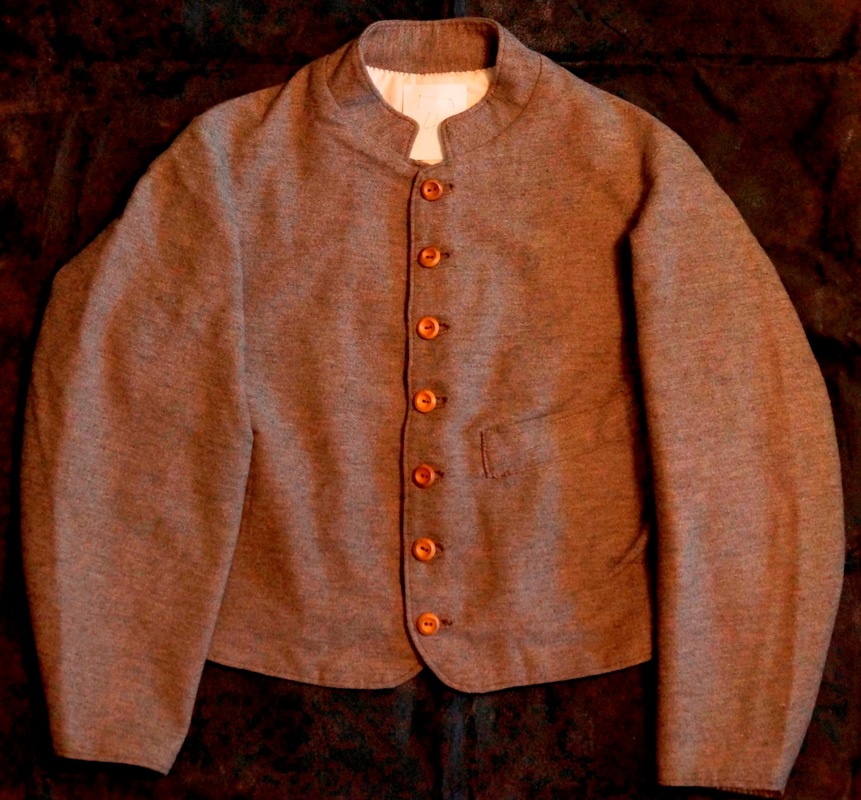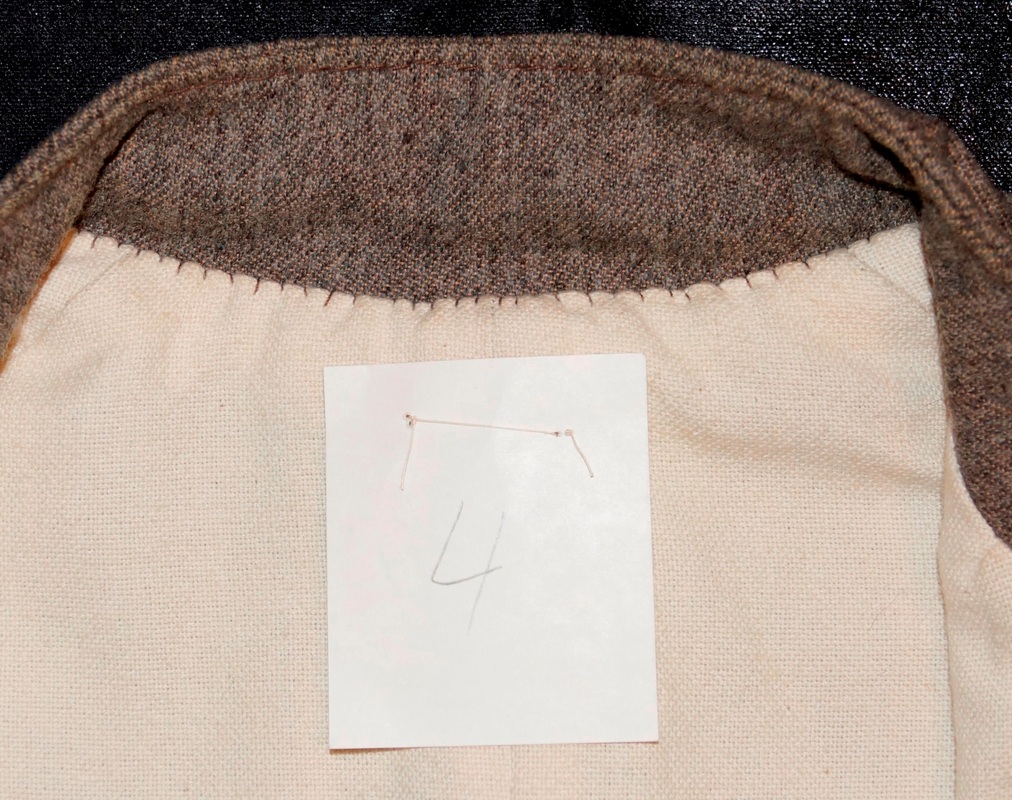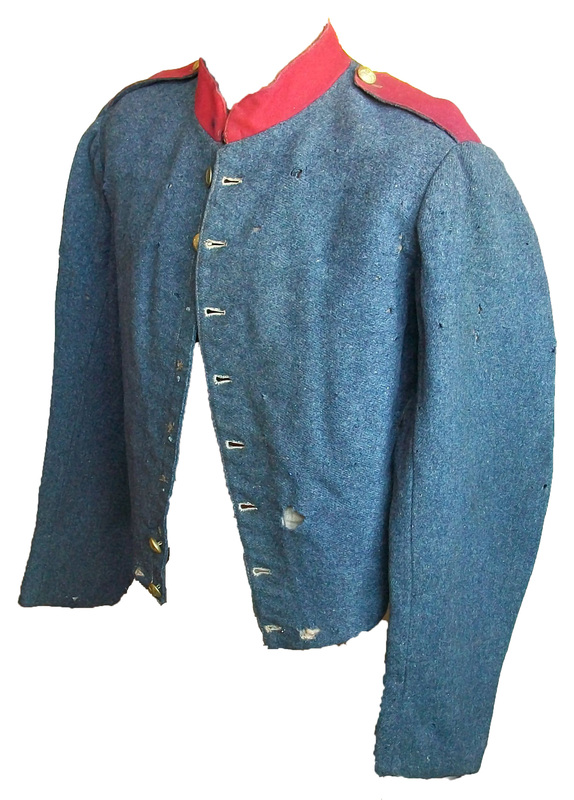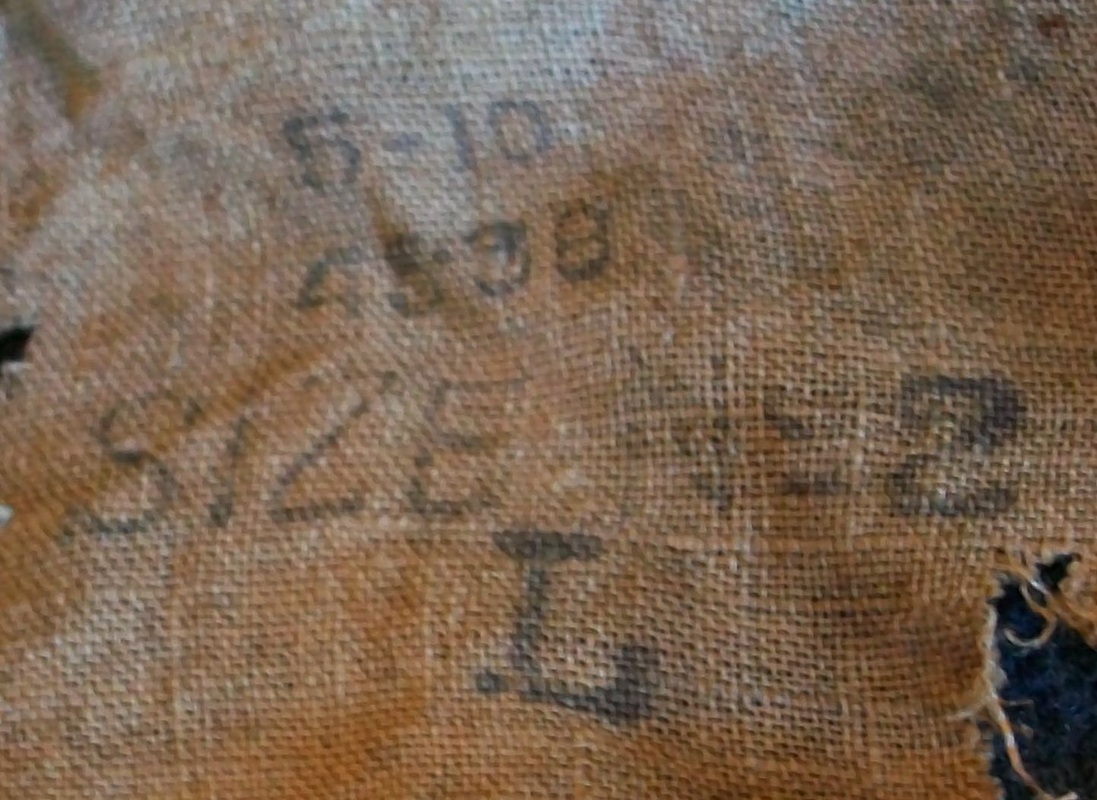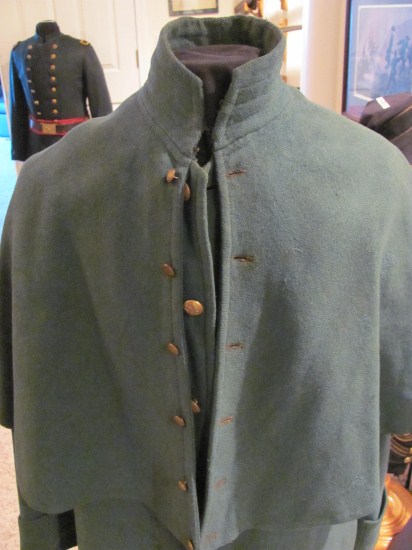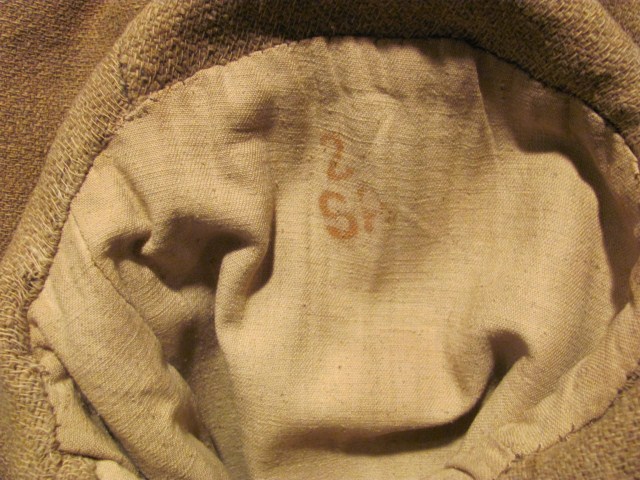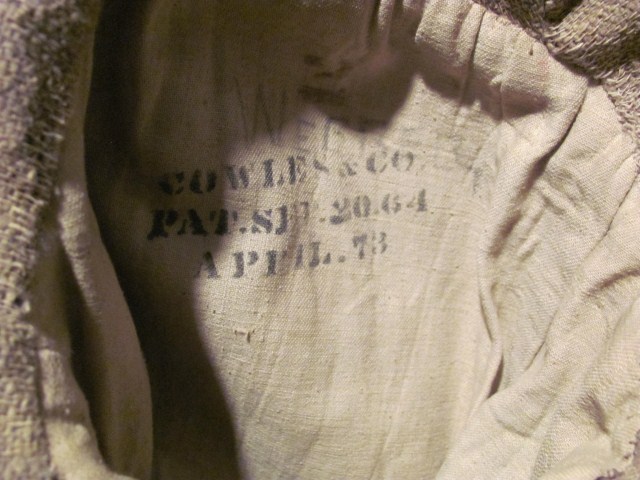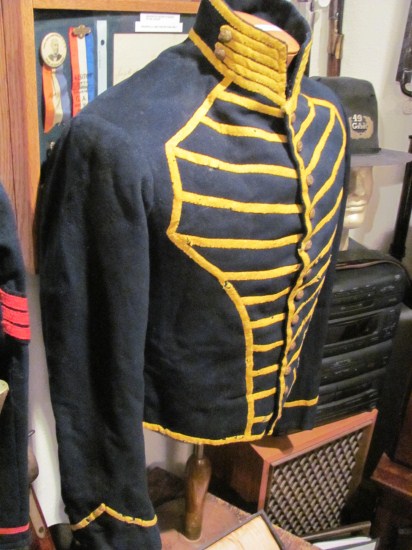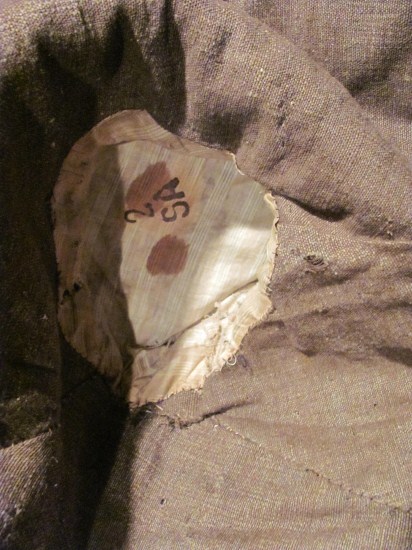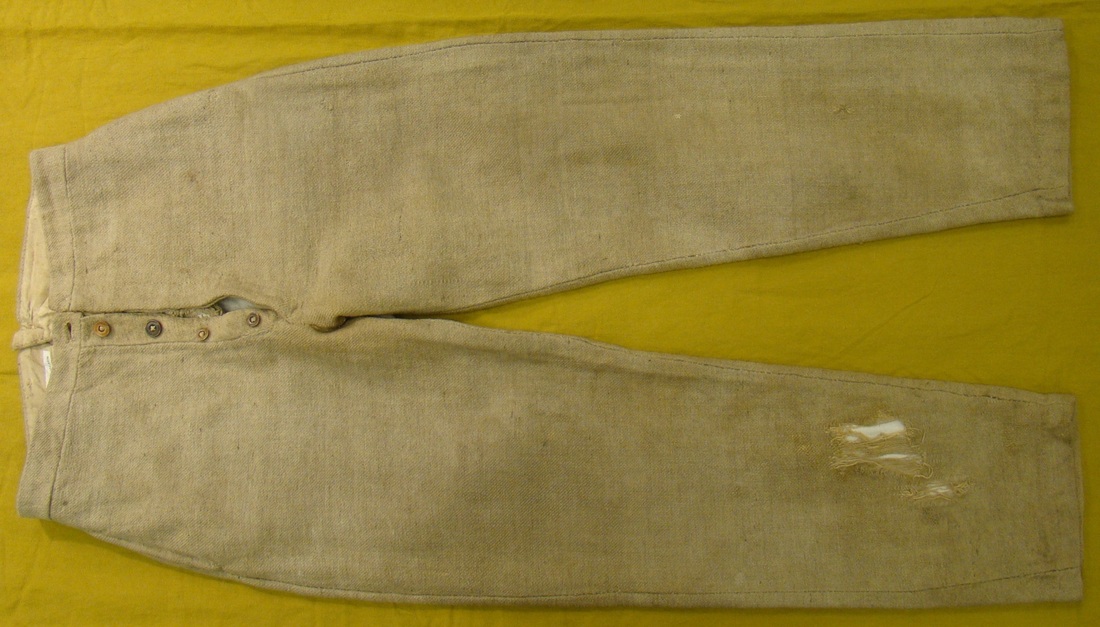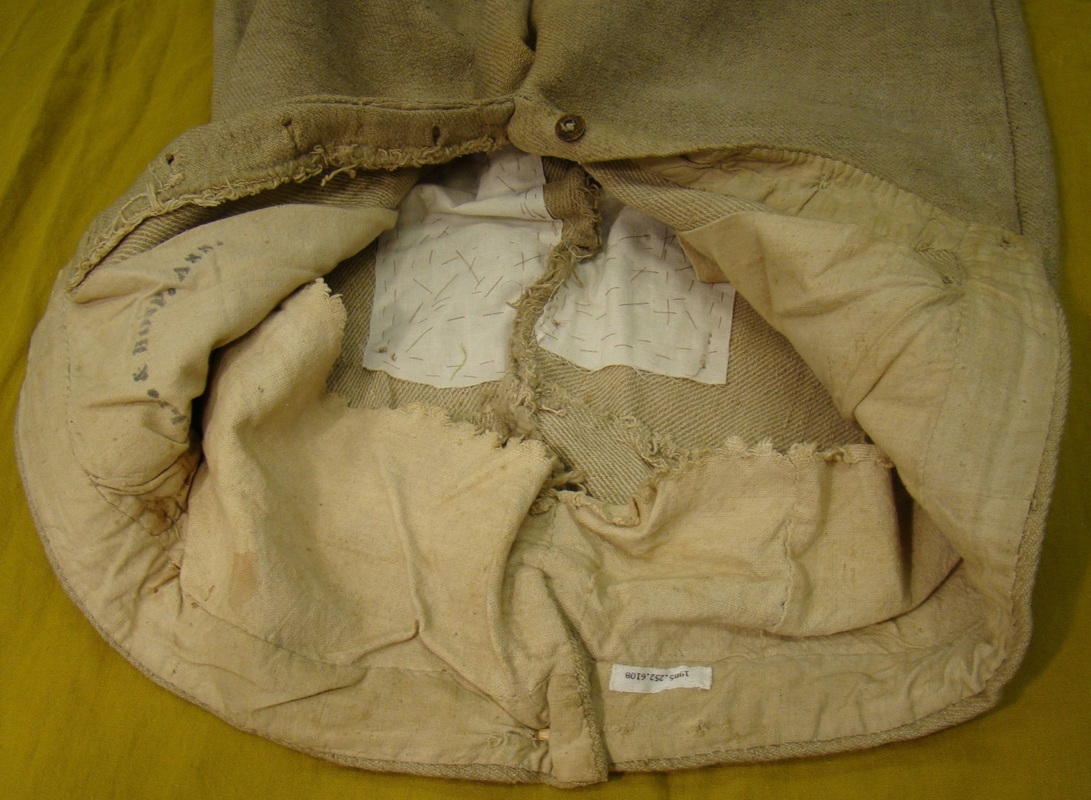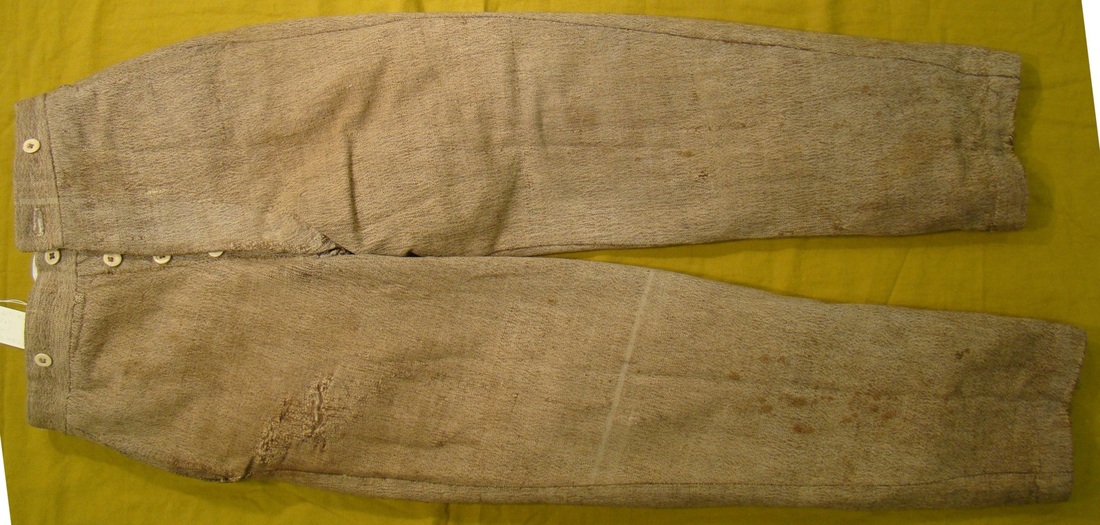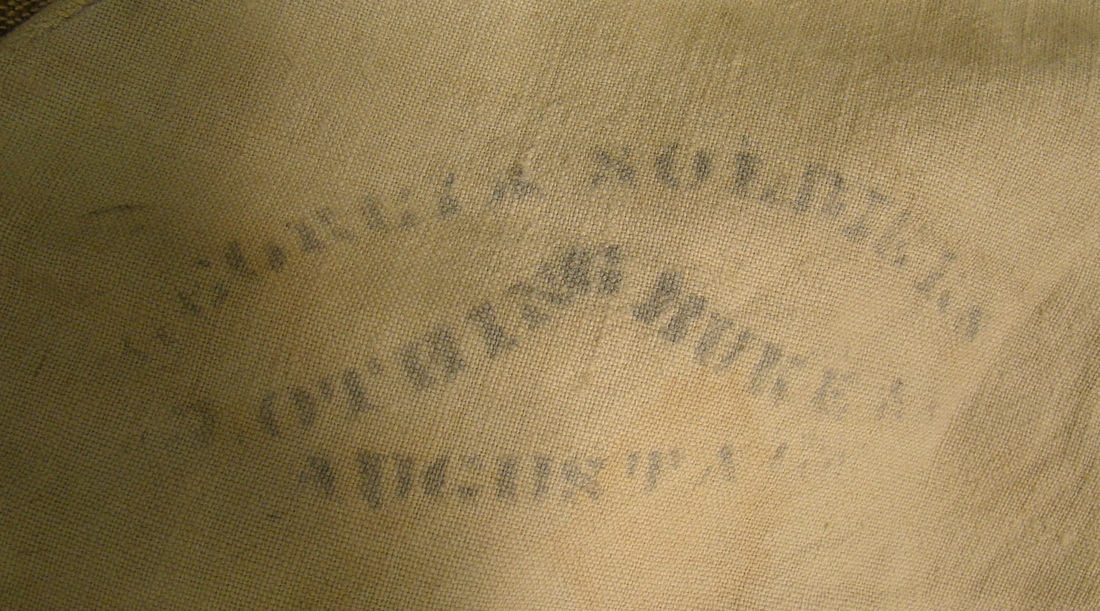Size and Manufacturer Markings in
Confederate Clothing
By Fred Adolphus, June 1, 2014
During my viewings of original Confederate uniforms, I have often pondered the complete lack of size markings and manufacturer's stamps. I usually dismissed this observance to Southern lack of resources, wooden stamps, etc. Despite that, it just never made any sense to me. I could understand a lack of manufacturer's stamps, but for clothing not to be marked with its size? It just did not add up.
I finally stumbled across the answer to this question while reading the instructions for making, marking and packing clothing published by the State of Alabama, August 26, 1861. Aside from the specifications for how to make uniform jackets, pantaloons, and great coats, the state included the required pattern sizes and the method of marking the clothing. Accordingly, "The number of different sizes of shirts, drawers, &c., should be the same as those of the coats and pantaloons, and particular care should be taken, to sew a card with the number of the size of the pattern marked upon it, firmly to each article." This method, I believe, is typical of how manufacturers marked all quartermaster clothing in the South. They may not have had ink stamps, but it would have been cheap and easy to loosely baste a piece of paper to the garment with its corresponding size number penciled on the card.
By Fred Adolphus, June 1, 2014
During my viewings of original Confederate uniforms, I have often pondered the complete lack of size markings and manufacturer's stamps. I usually dismissed this observance to Southern lack of resources, wooden stamps, etc. Despite that, it just never made any sense to me. I could understand a lack of manufacturer's stamps, but for clothing not to be marked with its size? It just did not add up.
I finally stumbled across the answer to this question while reading the instructions for making, marking and packing clothing published by the State of Alabama, August 26, 1861. Aside from the specifications for how to make uniform jackets, pantaloons, and great coats, the state included the required pattern sizes and the method of marking the clothing. Accordingly, "The number of different sizes of shirts, drawers, &c., should be the same as those of the coats and pantaloons, and particular care should be taken, to sew a card with the number of the size of the pattern marked upon it, firmly to each article." This method, I believe, is typical of how manufacturers marked all quartermaster clothing in the South. They may not have had ink stamps, but it would have been cheap and easy to loosely baste a piece of paper to the garment with its corresponding size number penciled on the card.
Confederate
uniform sizes corresponded roughly to those used by the Union army. The State of Alabama, for instance required
the following sizes: "The following are the numbers of each pattern
required to be made out of each one hundred, and in that proportion of a
smaller or greater number. Pattern No. 1,
25 each; Pattern No. 2, 30 each; Pattern No. 3, 25 each; Pattern No. 4, 15
each; Pattern No. 5, 5 each.[1] Using the Union army system of sizes, a Size
1 artillery jacket fit a 36 inch chest and 32 inch waist; a Size 2 fit a 38
inch chest and a 34 inch waist; a Size 3 fit a 40 inch chest and a 36 inch
waist; and a Size 4 fit a 42 inch chest and a 38 inch waist. Likewise, a Size 1 pair of trousers fit a 31
inch inseam and 32 inch waist; a Size 2 fit a 32 inch inseam and a 34 inch
waist; a Size 3 fit a 33 inch inseam and a 36 inch waist; and a Size 4 fit a 34
inch inseam and a 38 inch waist.[2] The Union sizes were probably similar to the
Confederate sizes, both systems having the same historical basis.
The imported Confederate clothing, best represented by the surviving Peter Tait & Company jackets, includes ink stamps in the lining, near the collar. These markings provide the jacket's size, and are based upon the British army system sizes. This system was far more extensive than the American system, and included approximately twenty-three different jacket sizes, and thirty different trousers sizes.[3] The Union army stamped its uniforms similarly, putting both manufacturer's and size markings in the sleeve linings near the arm skye.
The imported Confederate clothing, best represented by the surviving Peter Tait & Company jackets, includes ink stamps in the lining, near the collar. These markings provide the jacket's size, and are based upon the British army system sizes. This system was far more extensive than the American system, and included approximately twenty-three different jacket sizes, and thirty different trousers sizes.[3] The Union army stamped its uniforms similarly, putting both manufacturer's and size markings in the sleeve linings near the arm skye.
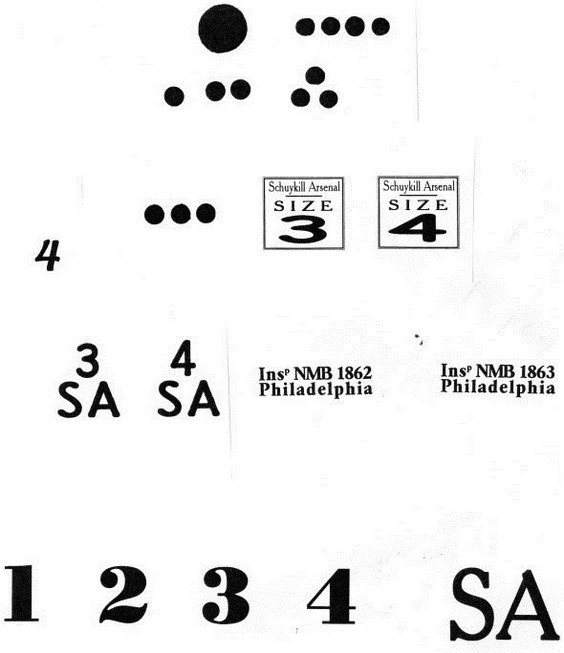
Image 7: Curt Schmidt developed this table depicting numerous markings stamped in Union clothing. According author Aaron Young's article "The Fatigue Blouse," manufacturers stamped contractor and inspector markings, as well as sizes, in the sleeve linings. Early size markings were indicated by numbers of dots to accommodate illiterates, but this system yielded to Arabic numerals after 1862. The number of dots corresponded to the size of the garment. The Schuykill Arsenal used red dots, and other arsenals used black dots. After the universal adoption of Arabic numerals, some arsenals continued to apply dots, as well as numerals.[4]
The
long-standing mystery about Confederate size markings is solved, but it is
still disappointing that Confederate clothing did not generally have
manufacturer's stamps. In fact, I know
of only two such stamps, and both are in clothing issued by the State of
Georgia. The first stamp is well-known,
having been pictured in the Time-Life series, Echoes of Glory, Arms and
Equipment of the Confederacy. This is
the stamp of the Georgia Relief & Hospital Association in the lining of
Lieutenant Hamilton Branch's trousers.
The other is in Private John McNish Hazlehurst's trousers, from the Georgia
Soldiers Clothing Bureau, Augusta, Georgia.
Incredibly, this stamp remained undiscovered until April 2013, when I
was viewing the uniforms of the Wray collection at the Atlanta History Center. While looking at the pocket lining of
Hazlehurst's pants, I saw the stamp. I
called Dr. Gordon Jones to look at it,
remarking that I had not been aware of it.
Dr. Jones was excited to see the stamp, because he himself had not known
about its presence, and then we both had a long moment of exultation realizing
that we had just discovered the only other known, Confederate manufacturer
stamp, aside from that in the Branch trousers.
It only makes sense that Confederate quartermasters included sizes in their government clothing. Sewing in paper cards with the size numbers marked on them offered the perfect alternative to using wooden ink stamps. Given the extra expense involved with stamping clothing, it is understandable that Southern manufacturers scrimped on this formality. Indeed, we are lucky to have the two extant Georgia manufacturer's markings in the Branch and Hazlehurst trousers.
The author extends his gratitude to all of the institutions and private individuals who made the images in this article available (as credited in the captions). Special thanks is extended to Dr. Gordon Jones, Chief Curator for Military History of the Atlanta History Center, for facilitating my extensive research on their Confederate artifacts. Readers are reminded that the images herein are the property of Adolphus Confederate Uniforms. Even if an artifact or image is credited to a public institution, the image itself is the property of this website, having been made by, purchased by or given usage of to the author. The exception to this is Curt Schmidt's graphic table, which was posted in the public domain on the Authentic Campaigner website. Please do not reproduce these images without the obtaining the author's consent.
Bibliography
[1] Circular: To the Soldiers' Aid Societies Throughout the State [of Alabama], [from the] Executive Department, Montgomery, Alabama, August 26th, 1861. The circular provided specifications for the making, marking and packing of Alabama State uniforms, and was printed in newspapers throughout the state. This information was provided to me by Historian Mike Bailey, Fort Morgan State Historic Site, Gulf Shores, Alabama.
[2] CJ Daley Historical Reproductions, Research Center page, May 2014, http://www.cjdaley.com/ research.
[3] Waite, John E., Peter Tait: A Remarkable Story, Milnford Publications, Great Britain, 2005, Appendix B, pp. 305-306, Scale of Sizes for Uniform Tunics and Trousers, British Infantry Regiment, 1858. It is difficult to count the exact number of sizes manufactured, due to what may be duplication in actual manufacturing, but the scale proves that the British army offered a vastly wider spectrum of sizes than the US army.
[4] Table of markings by Curt Schmidt, Authentic Campaigner forum; Historical information from Aaron Young, The Fatigue Blouse, Joe Strauser's Gentleman's Joe website, circa 2000.
The author extends his gratitude to all of the institutions and private individuals who made the images in this article available (as credited in the captions). Special thanks is extended to Dr. Gordon Jones, Chief Curator for Military History of the Atlanta History Center, for facilitating my extensive research on their Confederate artifacts. Readers are reminded that the images herein are the property of Adolphus Confederate Uniforms. Even if an artifact or image is credited to a public institution, the image itself is the property of this website, having been made by, purchased by or given usage of to the author. The exception to this is Curt Schmidt's graphic table, which was posted in the public domain on the Authentic Campaigner website. Please do not reproduce these images without the obtaining the author's consent.
Bibliography
[1] Circular: To the Soldiers' Aid Societies Throughout the State [of Alabama], [from the] Executive Department, Montgomery, Alabama, August 26th, 1861. The circular provided specifications for the making, marking and packing of Alabama State uniforms, and was printed in newspapers throughout the state. This information was provided to me by Historian Mike Bailey, Fort Morgan State Historic Site, Gulf Shores, Alabama.
[2] CJ Daley Historical Reproductions, Research Center page, May 2014, http://www.cjdaley.com/ research.
[3] Waite, John E., Peter Tait: A Remarkable Story, Milnford Publications, Great Britain, 2005, Appendix B, pp. 305-306, Scale of Sizes for Uniform Tunics and Trousers, British Infantry Regiment, 1858. It is difficult to count the exact number of sizes manufactured, due to what may be duplication in actual manufacturing, but the scale proves that the British army offered a vastly wider spectrum of sizes than the US army.
[4] Table of markings by Curt Schmidt, Authentic Campaigner forum; Historical information from Aaron Young, The Fatigue Blouse, Joe Strauser's Gentleman's Joe website, circa 2000.
